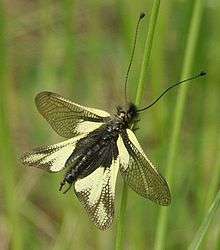Ascalaphidae
Ascalaphidae is a family of insects in the order Neuroptera, generally called owlflies. They are crepuscular or diurnal predators of other flying insects, and have large bulging eyes and strongly knobbed antennae.
| Ascalaphidae | |
|---|---|
.jpg) | |
| Libelloides macaronius | |
| Scientific classification | |
| Kingdom: | Animalia |
| Phylum: | Arthropoda |
| Class: | Insecta |
| Order: | Neuroptera |
| Suborder: | Myrmeleontiformia |
| Family: | Ascalaphidae Rambur, 1842 |
| Subfamilies | |
and see text | |
Description
Owlflies are readily distinguished from dragonflies by their long, clubbed antennae; the latter have short, bristle-like antennae. The closely related antlions (family Myrmeleontidae) have short, weakly clubbed antennae, smaller eyes, and different wing venation.[1] All but one species of Ascalaphidae have long antennae, easily distinguishing them. The sole exception is the Brazilian Albardia furcata, the only living member of the subfamily Albardiinae, which has short antennae, but these are strongly clubbed (compared to myrmeleontids), and its wing venation is reticulate, typical of ascalaphids. Most owlflies are about 1.5 inches in length, not including antennae.[2] Adult Ululodinae such as Ululodes have large divided eyes and crepuscular habits, which is where the common name "owlfly" came from.[2] Owlflies are worldwide in distribution, occurring in temperate and tropical habitats.
Ecology
Adult owlflies are fast-flying, aerial predators, capturing and feeding on other insects in flight.[3] Adults of many New World species are most active at sunset, and can often be collected near lights. During the day, adults rest on stems and twigs with the body, legs, and antennae pressed to the stem.[2] Some Old World species, such as Libelloides macaronius, are active during the day, and are brightly colored; many of them also hold their wings spread at rest like dragonflies.
Anti-predator defences
The abdomen in many crepuscular species is raised at rest, mimicking a broken twig.[2] When disturbed, some owlflies release a strong, musk-like chemical to deter enemies.[2]
Some New World species such as Haploglenius luteus are able to suddenly reflex a flap on the pronotum, exposing a strongly-contrasting patch of pale colour (white or cream), either as a deimatic display to startle predators[4], or as heliographic signalling to attract females.[5]
Life cycle
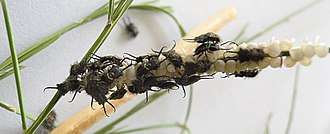
_(6801861092).jpg)
Eggs are laid on twigs or plant stems. Owlfly larvae are ambush predators, and sequester themselves at the soil surface, in ground litter, or on vegetation, sometimes covered with debris, and wait for prey, which they seize with their large, toothed mandibles. They resemble antlion larvae, but have an elongate, sometimes finger-like appendage on the side of each segment called a scolus-like process.[6] In some genera, larvae actively place sand and debris onto their dorsum as camouflage. Pupation occurs in a spheroidal silk cocoon in leaf litter or soil.[7]
Evolution
Owlflies appear to have evolved from a common ancestor with Stilbopterygidae.[8] These, in turn, evolved from a common ancestor with Palparidae, which evolved from a common ancestor with the true antlions, or Myrmeleontidae.[8]
Fossil history
The owlflies are an ancient group, dating back to the mid-Mesozoic at least. A number of fossil owlflies and owlfly larvae have been found, often encased in amber. Most of these also cannot be placed in a particular subfamily. Most are known from the Oligocene; the Late Jurassic Mesascalaphus may be an entirely more basal member of the family. but it is now believed to be a member of Mesochrysopidae . Fossil owlfly genera incertae sedis include Ascaloptynx, Borgia, Mesascalaphus, Neadelphus, Prosuhpalacsa and Ricartus.[9] Cratopteryx from the Early Cretaceous is probably a member of the Myrmeleontoidea; sometimes assigned to the Ascalaphidae, it is better considered incertae sedis.[9]
Phylogeny
Total evidence analysis (several genes + morphology) in 2019 recovered Ascalaphidae as monophyletic and found evidence for five subfamilies: Albardiinae van der Weele, 1909; Ululodinae van der Weele, 1909; Haplogleniinae Newman, 1853; Melambrotinae Tjeder, 1992; and Ascalaphinae Lefèbvre, 1842.[8] This followed nuclear phylogenomic analysis in 2018, which recovered Ascalaphidae as a paraphyletic lineage within Myrmeleontidae; authors in that paper sunk Ascalaphidae into the Myrmeleontidae as subfamily Ascalaphinae, and reduced in rank its subfamilies to tribes.[10] Molecular analysis in 2018 using mitochondrial rRNA and mitogenomic data also placed the Ascalaphidae as sister to the Myrmeleontidae as the most advanced groups within the Neuroptera.[11][12] The fossil record has contributed to an understanding of the group's phylogeny.[13][14][15]
External
Neuropteran subfamilies are described in Winterton et al 2017.[16]
| Neuropterida |
| ||||||||||||||||||||||||||||||||||||||||||||||||||||||||||||
References
- Foltz, John L. (August 10, 2004). "Neuroptera: Ascalaphidae". ENY 3005 Family Identification. University of Florida. Archived from the original on June 1, 2010. Retrieved July 14, 2010.
- Saad, Brooke; Pickens, Lindsey (2004). "Ululodes quadrimaculatus, "owlfly"". Clemson University. Archived from the original on October 12, 2008. Retrieved April 24, 2008.
- Britton, David (12 March 2019). "Life-history of an Owlfly". Australian Museum.
- New, Timothy R. (2014). Planipennia: Lacewings. De Gruyter. p. 51. ISBN 978-3-11-085881-5.
- Onore, G.; Badano, D.; Pantaleoni, R. A. (2014). "Heliographic signalling in Haploglenius Burmeister, 1839 (Neuroptera Ascalaphidae)" (PDF). Biodiversity Journal. 5 (1): 87–91.
- Badano, D.; Pantaleoni, R. A. (2014). "The Larvae of European Ascalaphidae (Neuroptera)". Zootaxa. 3796 (2): 287–319. doi:10.11646/zootaxa.3796.2.4.
- "Family Ascalaphidae - Owlflies". BugGuide. September 19, 2006. Retrieved April 24, 2008.
- Jones, Joshua R. (2019). "Total-evidence phylogeny of the owlflies (Neuroptera, Ascalaphidae) supports a new higher-level classification". Zoologica Scripta. 48: 761–782. doi:10.1111/zsc.12382.
- Engel, Michael S.; Grimaldi, David A. (2007). "The neuropterid fauna of Dominican and Mexican amber (Neuropterida, Megaloptera, Neuroptera)" (PDF). American Museum Novitates. 3587: 1–58. doi:10.1206/0003-0082(2007)3587[1:TNFODA]2.0.CO;2.
- Machado, R. J. P.; Gillung, J. P.; Winterton, S. L.; Garzon‐Orduña, I. J.; Lemmon, A. R.; Lemmon, E. M.; Oswald, J. D. (2018). "Owlflies are derived antlions: Anchored phylogenomics supports a new phylogeny and classification of Myrmeleontidae (Neuroptera)". Systematic Entomology. 44: 418–450. doi:10.1111/syen.12334.
- Yue, Bi-Song; Song, Nan; Lin, Aili; Zhao, Xincheng (2018). "Insight into higher-level phylogeny of Neuropterida: Evidence from secondary structures of mitochondrial rRNA genes and mitogenomic data". PLOS ONE. 13 (1): e0191826. doi:10.1371/journal.pone.0191826. ISSN 1932-6203.
- Yan, Y.; Wang Y, Liu, X.; Winterton, S. L.; Yang, D. (2014). "The First Mitochondrial Genomes of Antlion (Neuroptera: Myrmeleontidae) and Split-footed Lacewing (Neuroptera: Nymphidae), with Phylogenetic Implications of Myrmeleontiformia". Int J Biol Sci. 10 (8): 895–908. doi:10.7150/ijbs.9454. PMC 4147223.CS1 maint: multiple names: authors list (link)
- David Grimaldi & Michael S. Engel (2005). Evolution of the Insects. Cambridge University Press. ISBN 0-521-82149-5.
- Engel, M. S. & Grimaldi, D. A., 2007: The neuropterid fauna of Dominican and Mexican amber (Neuropterida: Megaloptera, Neuroptera). American Museum Novitates: #3587, pages 1-58
- Parker, S. P. (ed.), 1982: Synopsis and classification of living organisms. Vols. 1 & 2. McGrew-Hill Book Company
- Winterton, S. L.; Lemmon, A. R.; Gillung, J. P.; Garzon, I. J.; Badano, D.; Bakkes, D. K.; Breitkreuz, L. C. V.; Engel, M. S.; Lemmon, E. M.; Liu, X.; Machado, R. J. P.; Skevington, J. H.; Oswald, J. D. (2017). "Evolution of lacewings and allied orders using anchored phylogenomics (Neuroptera, Megaloptera, Raphidioptera)". Systematic Entomology. 43: 330–354. doi:10.1111/syen.12278.
External links
| Wikispecies has information related to Ascalaphidae |
| Wikimedia Commons has media related to Ascalaphidae. |

.jpg)
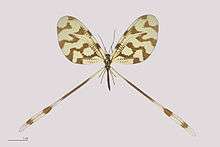
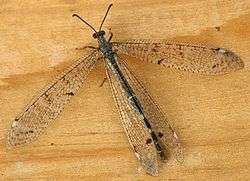
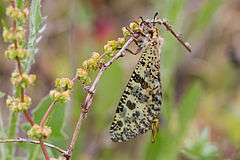
.jpg)
